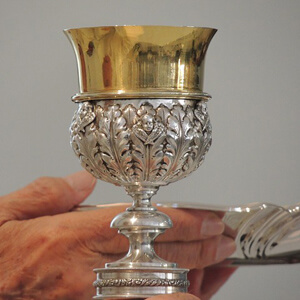
Thank you for the astute observation. I can see a lot of thought was put into it, and it is the first time I hear someone try to connect the offertory gifts with the quote from 1 John 5:6. I here quote in full:
This is he who came by water and blood, Jesus Christ, not with the water only but with the water and the blood.
Notice that the emphasis here is on “blood”, and not only water. Traditionally, this has been understood as water referring to baptism and blood to Jesus’ passion and the Eucharist. Later on in 1 John, the Holy Spirit is added for the triple testimony of Jesus.
Therefore, what John is talking about here is the integrity of Jesus’ ministry of cleansing our sins and giving of His life to us. It is also an emphasis on Jesus’ integrity of both fully God and fully man, both able to cleanse us, and able to and truly did die for us.
The symbolism of adding water to the wine in the chalice during the preparation of the gifts, however, comes from a very different meaning. In fact, strictly speaking, the water is not part of the offering, only the hosts and the wine are. And the water adding to the wine is not essential for the validity of the sacrament. As we know, there is no mention of adding water to the wine when Jesus celebrated the Last Supper. Only the host and wine are representing Christ.
The meaning of adding water to the wine can be found in the silent prayer the priest utters when it is added:
“By the mystery of this water and wine, may we come to share in the divinity of Christ, who humbled Himself to share in our humanity.”
The liturgical symbol of water here represents our humanity being submerged and transformed by the divinity of Christ. Just as Christ has joined humanity inseparably with His divinity, so we pray that this sacrament may achieve its goal, which is to unite us inseparably with Christ. And just as a drop of water in the wine is no longer water but one with the wine, so may our humanity be made more and more into Christ’s divinity.
Since this is merely a liturgical symbol, which is used as a sign to illustrate a point, (which is different from a sacrament like baptism or Eucharist, whose very action actually affects change of reality) it is not necessary for every chalice to have water added to it. The point is to show water is added to some of the wine. This is similar to the liturgical symbolic gesture of peace. We use it as a sign to offer Christ’s peace to our neighbours,, but it is not necessary for us to offer peace to every person in the congregation to achieve its symbolic meaning. It is a symbolic action in its most basic sense.
Having said the above, from the many places I have travelled to, I notice that there is currently a great variety of practice when multiple chalices are required. Some places do add water to every chalice, some would add water to the wine dispenser before pouring into the individual chalices, and some add only to the main celebrant’s chalice.


